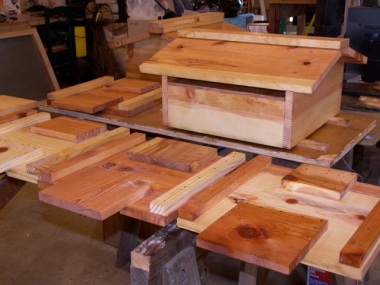In this section of the Warre Hive Construction Guide we will paint and finish the Warre beehive. Adding paint or finish to your beehive protects it from the rain and weather. Finishing a Warre hive is probably the easiest part of the building process. Let’s get started!
Step 1: Prepare the Parts
Take all of the Warre hive components you have built and lay them on some cardboard, newspaper or scrap wood. You can stack the hive boxes if you have more than one. You can also lay thin strips of across two saw horses to provide a place to paint the roof and floor as in the photo above. The quilt does not need to be painted.
Step 2: Apply the Finish
After you have set up your painting area, prepare the paint or finish of your choice and apply it. You can use a rag or paint brush for oil finishes and a paint brush for paint. Be sure to coat all the corners and joints of the hive parts as you apply the finish.
Step 3: Apply a Second Coat
When you are finished applying your finish of choice, let it dry for the period of time recommended by the manufacturers of the finish. When your Warre hive is dry, apply a second coat of finish to further weatherproof your Warre beehive.
Congratulations! You have now finished your Warre Hive! In the next section we will install the Warre Hive.























Hope things are warmer out west than here in Northern Illinois, Nick. Just completed a trial bottom section of the Warre Hive and by the measurements it seems small compared to the hives used commercially. How’s your packaged bees acclimating to this small size? I’m going to try and make the removable frame since I got the okay from our state inspectors office.
Thanks and Happy Holidays
Keith – I am keeping warm…although the temp is around 25F and there is snow everywhere. Maybe that is warmer than Illinois! 🙂
The Warre Hive is smaller than a Langstroth, but that makes for easier handling. It is a lot lighter too when you have a box full of honey. The package bees I hived last spring did well in the Warre. Good luck with the frames! Send me some photos if you want, and I will post them!
What sort of paint do you use? Just latex exterior? For a nude covering, what’s best – lynseed oil? I just read something on the warre yahoo group that painting the front of the hive white is a good idea, so that bees can more easily see the high contrast with the opening of the hive.
Laura – I like to use 2 coats of linseed oil on my hives. I just leave my cedar hives bare without paint or finish.
Both latex paint and linseed oil work well. Do not use shellac or varnish on your hive. It prevents the beehive from breathing.
Nick: First of all many thanks for this beautifull manual. Currently I’m constructing my own Warré hive. I would like to finish the hive with linseed oil and I received a leftover from a friend. However it seems that pure lineseed oil does not dry. What do you add to the lineseed oil to let it dry properly?
do you no how to build frames for your bee hives if so can you help me
chad – Yes, I can. There is a great frame design at http://warre.biobees.com/denis.htm Denis is a beekeeping in France and he developed a half frame which is the best frame solution for the Warre Hive that I have seen.
I live in alaska and the mornings can be chilly, even in the middle of summer. What do you think about painting the hive black? Would it get too hot inside? I can place my hives where they get the morning sun but is shaded in the evenings.
I just thought painting it a dark color would help give them a boost in the mornings but not sure if it would get too hot. It sure would help in the spring and fall too. Maybe someone with more experience has the answer!
Thank you in advance,
Jordan
Great blog and site! I am really excited to see warre hives in use!
Way to go!
Eliese
I use a finish in my wood shop that is half mineral oil and half beeswax. Would the bees be bothered by the beeswax on the walls? Thanks Dennis
That should work fine Dennis, remember, you are only applying finish to the outside of the hive.
Hello everyone..I have built a Warre hive using 2″ ruff cut pine.
It is now waiting for a protective finish…What are the best choices for finish since I live in Vermont U.S.A. Is the raw linseed oil and beesax really all i need and do i have to sand the rufff cut wood first?